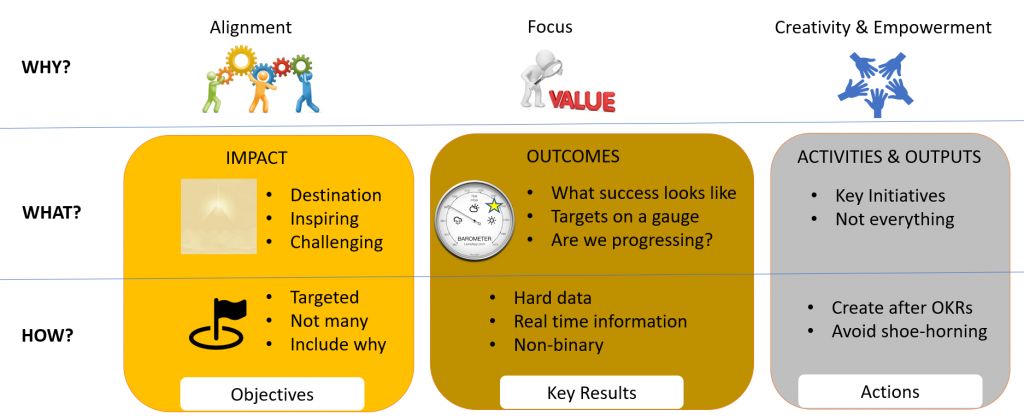By Paul Blay November 17, 2020
If you’re interested in a way to tap into your team or companies creative potential, generating alignment and delivering tangible value, then OKRs should be your first port of call.
I was fortunate enough to have met, and worked closely with Ragan McGill while I was at DisplayLink. Ragan had experienced both effective and underwhelming use of OKRs in his career and gave a set of training on how to ensure that they are well formed and deliver on their potential.
I was inspired by the ideas and, after having put them to practice ourselves, am now completely sold. As a result, I had worked on my own presentation of the ideas and started coaching the teams in the company that were struggling with the concept.
This post tries to cover the core ideas, so that you can tap into the potential of OKRs too.
What Are OKRs?
OKRs stand for Objectives and Key Results and they are a framework for goal setting. Here’s a basic overview, we’ll go into more detail in a moment.
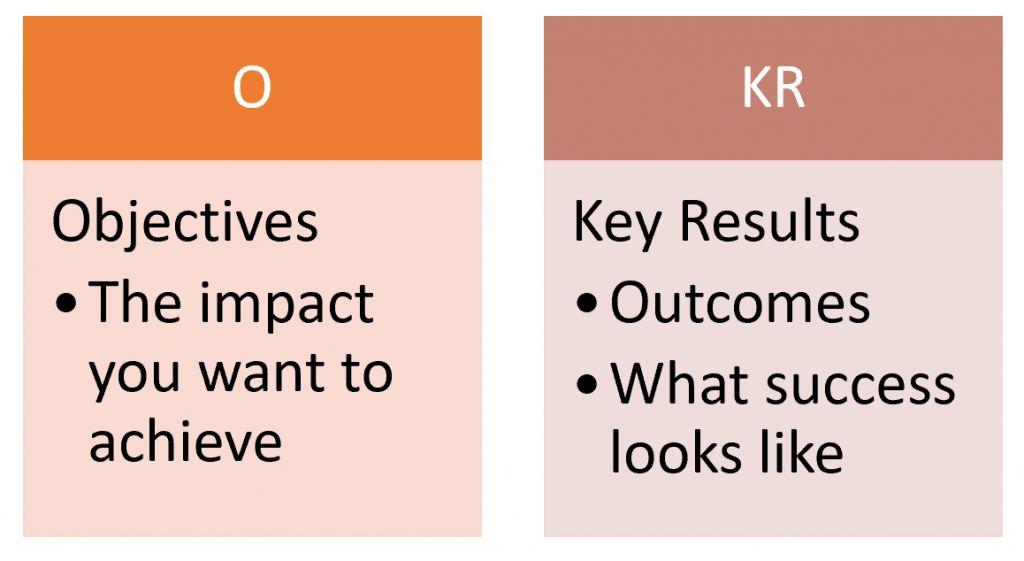
Why OKRs?
I’ve already touched on this in the opening paragraph, but to expand on that:

- Alignment in where we want to go and what success looks like. OKRs provide this alongside flexibility in how we get there.
- Teams are empowered as they have autonomy on how to achieve the objectives.
- Once the teams are on the same page, collaboration is enhanced and the objective should be challenging which, alongside empowerment/flexibility, helps promote creativity.
- The focus of our efforts moves from ‘features’ to value.
The Focus On Value
Traditional project management may start with a value proposition, but once the project is in execution, it’s rare that the teams understand the value or that it ever gets reviewed. The focus is primarily on achieving the outputs with a focus on inputs, activities and the output timeline.
Taking the INTRAC result chain to illustrate:

The INTRAC results chain maps to OKRs and Actions in the following way. Are you spending all your time focusing on Actions?

OKRs enable you to maintain focus on the impact you want and monitor your progress with measurable outcomes. Rely on the creativity and skills of your teams to decide on the actions required to achieve these.
An Analogy
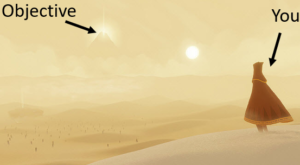
Imagine this is you. Think of the Objective in an OKR to be a place you want to reach, illustrated here by the peak of a glorious mountain, depicted in the computer game Journey.
Even to you, the path to get there is not completely clear.
Worse still, you are not going to be the one taking the majority of the actions in order to get there, you have teams of experts that you need to draw on.
For your teams, the Objective is even less clear than for you.
Imagine your teams are at the controls of a ridiculously complex vehicle filled with different, specialist kit that need to work in unison to get the thing moving at all, let alone in the right direction. Some of the specialist stations can’t even see out of the window, and for those that can, it’s awfully foggy outside.
Fortunately, you have the ability to work with the team to define and monitor KRs.
You can think of KRs as a set of metrics that, together, reasonably identify whether you have reached your Objective.
Importantly, the teams need to have these metrics highly visible to them and they should be points on a measure that’s updating in real time.
An example of this, extending the Journey analogy, is Latitude or Longitude. If you know that the peak of your mountain (objective) is at 51.1789° N, 1.8262° W then these could be your Key Results. Given your teams have Latitude and Longitude metrics available to them – then every action they take results in moving the current metrics closer or further away from the Key Results.
So think of KRs as points on a measurable scale. Imagine your teams looking at a dashboard with the KRs marked out on various dials and gauges. Even though it’s low visibility to the Objective, every action they take changes the measurements to let them know if they’re getting closer or further away.
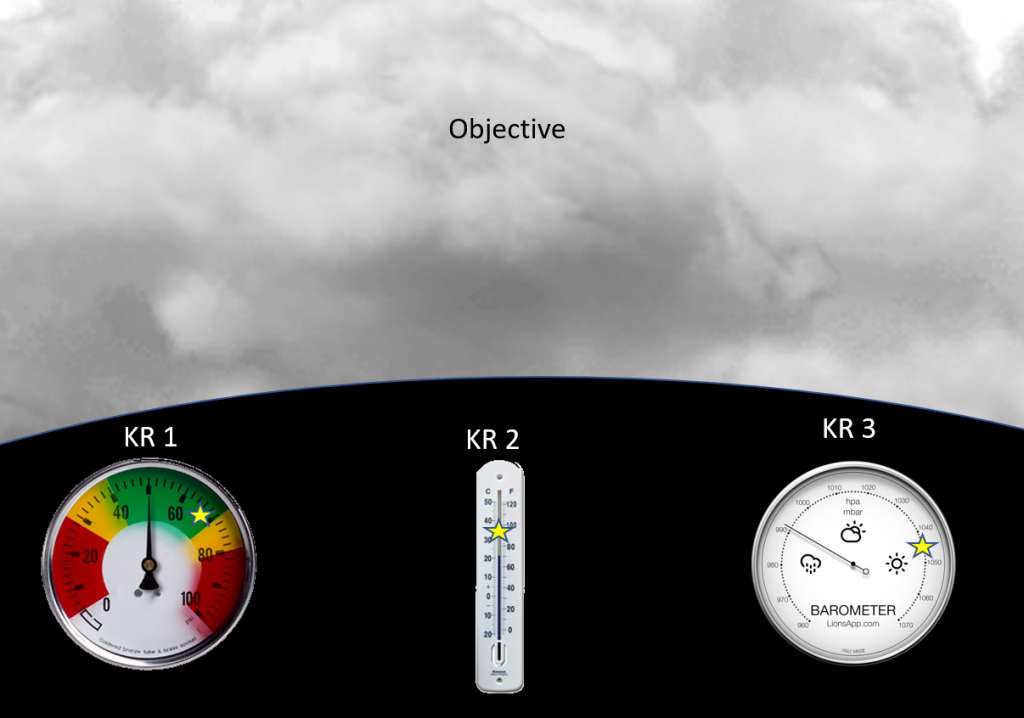
Looking out into the fog, your team works on actions to get their measurements moving towards the KRs (represented as stars on the dashboard readings in this illustration).
Setting Effective OKRs
The types of mistakes I see often are:
Having too many OKRs
- To get the most out of people, they need focus. Take them one or two at a time and be aware that not all work must sit within an OKR.
The bosses KRs becoming the subordinates Objectives
- Objectives are Impacts and Key Results are Outcomes. They are fundamentally different concepts.
Trying to shoehorn known work into OKRs
- Looking at the actions first and trying to create OKRs to capture them is exactly backwards.
Dressing up Outputs and Activities as Objectives and Key Results
- We’re so used to thinking about projects and actions, but OKRs focus on things you don’t have direct control over.
Objections that the OKRs are not solely influenced by our actions
- This is a scary thought but necessary. If the culture is one of support and collaboration, the rewards will come.
Remember:
- OKRs are difficult to do well, try your best and iterate.
- Achieving 70% of your KRs is a success.
Objectives
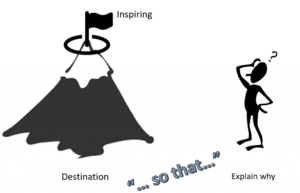
- Objectives are Impacts
- Make them a destination
- Make them inspiring
- Make them challenging
- Explain why, use “so that”
- Start with 1 or 2
Key Results

- KRs are Outcomes
- Define what success looks like
- Make them numerical
- Use a scale that can be measured in real time (or as close as possible)
- Avoid binary KRs
- Avoid actions. If you can achieve it directly, it’s not a KR.
- Include the initial value of the metric when describing the KR e.g. “Decrease defects in the field from 100 to 10”
In Conclusion
OKRs are extremely powerful when used well and in the right company culture. I hope this post has helped you understand and apply them better for your business.
I leave you with a summary adding actions, as a concept, into the mix.
